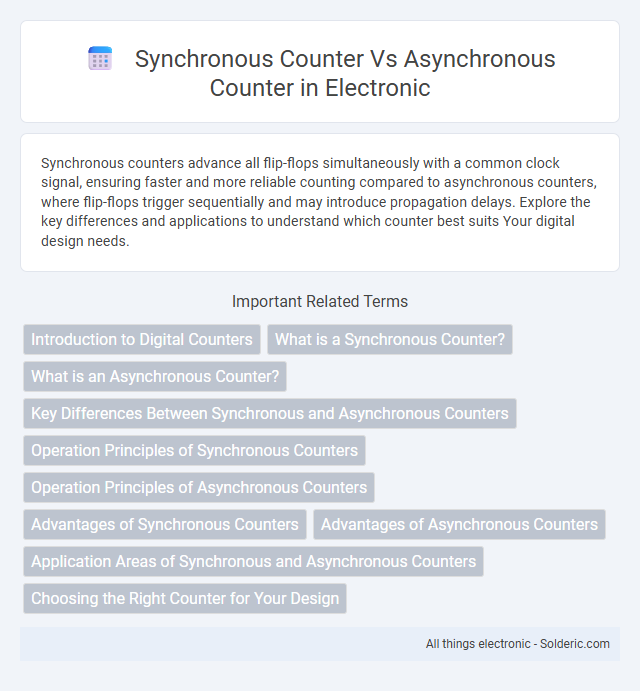Synchronous counters advance all flip-flops simultaneously with a common clock signal, ensuring faster and more reliable counting compared to asynchronous counters, where flip-flops trigger sequentially and may introduce propagation delays. Explore the key differences and applications to understand which counter best suits Your digital design needs.
Comparison Table
| Feature | Synchronous Counter | Asynchronous Counter |
|---|---|---|
| Clocking | All flip-flops triggered simultaneously by a common clock | Flip-flops triggered one after another; output of one is clock input for next |
| Speed | Faster, minimal propagation delay | Slower, cumulative propagation delay |
| Complexity | More complex circuit design | Simpler design and easier to implement |
| Applications | High-speed counting, digital clocks, frequency counters | Low-speed applications and simple counting tasks |
| Output Glitch | Less prone to glitches | More prone to glitches due to ripple effect |
| Power Consumption | Higher due to simultaneous switching | Lower power consumption |
| Scalability | Better scalability to higher bit counts | Limited scalability due to delay accumulation |
Introduction to Digital Counters
Digital counters are essential circuits in digital electronics used to count pulses and keep track of occurrences. Synchronous counters operate with all flip-flops triggered simultaneously by a common clock signal, ensuring faster and more reliable counting. Asynchronous counters, in contrast, trigger flip-flops sequentially, resulting in slower response times due to propagation delays but simpler design.
What is a Synchronous Counter?
A synchronous counter is a digital counting device where all flip-flops are triggered simultaneously by a common clock signal, ensuring precise timing and uniform output transitions. It offers faster operation and reduced propagation delay compared to asynchronous counters, making it ideal for high-speed applications. Your choice of a synchronous counter enhances counting accuracy and synchronization in digital circuits.
What is an Asynchronous Counter?
An asynchronous counter, also known as a ripple counter, is a type of digital counter where the flip-flops are triggered sequentially by the output of the previous stage rather than a common clock signal. This results in a delay that propagates through each flip-flop, causing slower overall operation compared to synchronous counters. Asynchronous counters are simpler in design but less suitable for high-speed applications due to the ripple effect in timing.
Key Differences Between Synchronous and Asynchronous Counters
Synchronous counters operate with all flip-flops triggered simultaneously by a common clock signal, resulting in faster and more predictable counting performance compared to asynchronous counters, where flip-flops are triggered in a ripple fashion, causing propagation delays. Asynchronous counters suffer from cumulative delay since each flip-flop triggers the next, limiting their speed and accuracy in high-frequency applications. Synchronous counters provide better timing control and are preferred for precise digital counting tasks requiring minimal propagation delay.
Operation Principles of Synchronous Counters
Synchronous counters operate by triggering all flip-flops simultaneously with a common clock signal, ensuring that the state changes occur in unison. This simultaneous operation eliminates the propagation delay found in asynchronous counters, where flip-flops are triggered sequentially, resulting in faster and more reliable performance. The synchronous design enhances accuracy in digital circuits requiring precise timing, such as frequency dividers and digital clocks.
Operation Principles of Asynchronous Counters
Asynchronous counters operate based on a ripple effect where the output of one flip-flop serves as the clock input for the next flip-flop, causing each bit to change state at different times. This sequential triggering results in propagation delay, where changes occur progressively rather than simultaneously across all bits. These counters are simpler and require fewer clock signals but suffer from slower operation speeds compared to synchronous counters due to cumulative delays.
Advantages of Synchronous Counters
Synchronous counters offer precise timing control because all flip-flops are triggered simultaneously by a common clock signal, eliminating propagation delay issues found in asynchronous counters. This parallel operation enables higher counting speeds and improved reliability in digital circuits. Enhanced performance and scalability make synchronous counters ideal for complex timing and counting applications.
Advantages of Asynchronous Counters
Asynchronous counters offer simplicity in design and require fewer hardware resources compared to synchronous counters, resulting in lower overall cost and power consumption. Their straightforward architecture allows for faster implementation in low-frequency applications where timing precision is less critical. These counters are ideal for basic counting tasks where reduced complexity and minimal wiring are advantageous.
Application Areas of Synchronous and Asynchronous Counters
Synchronous counters are widely applied in digital clocks, frequency dividers, and synchronous state machines where precise timing and simultaneous state changes are crucial. Asynchronous counters find use in simple counting tasks, event counting, and low-speed applications such as digital watches and basic frequency counters due to their simpler design and lower power consumption. Understanding your specific timing and synchronization needs helps determine whether a synchronous or asynchronous counter is ideal for your application.
Choosing the Right Counter for Your Design
Selecting the appropriate counter depends on timing requirements and complexity. Synchronous counters provide precise timing by triggering all flip-flops simultaneously, making them ideal for high-speed or complex circuits. Asynchronous counters offer simpler designs and lower power consumption, but their ripple effect limits their use in applications needing fast, accurate counting.
Synchronous counter vs Asynchronous counter Infographic

 solderic.com
solderic.com